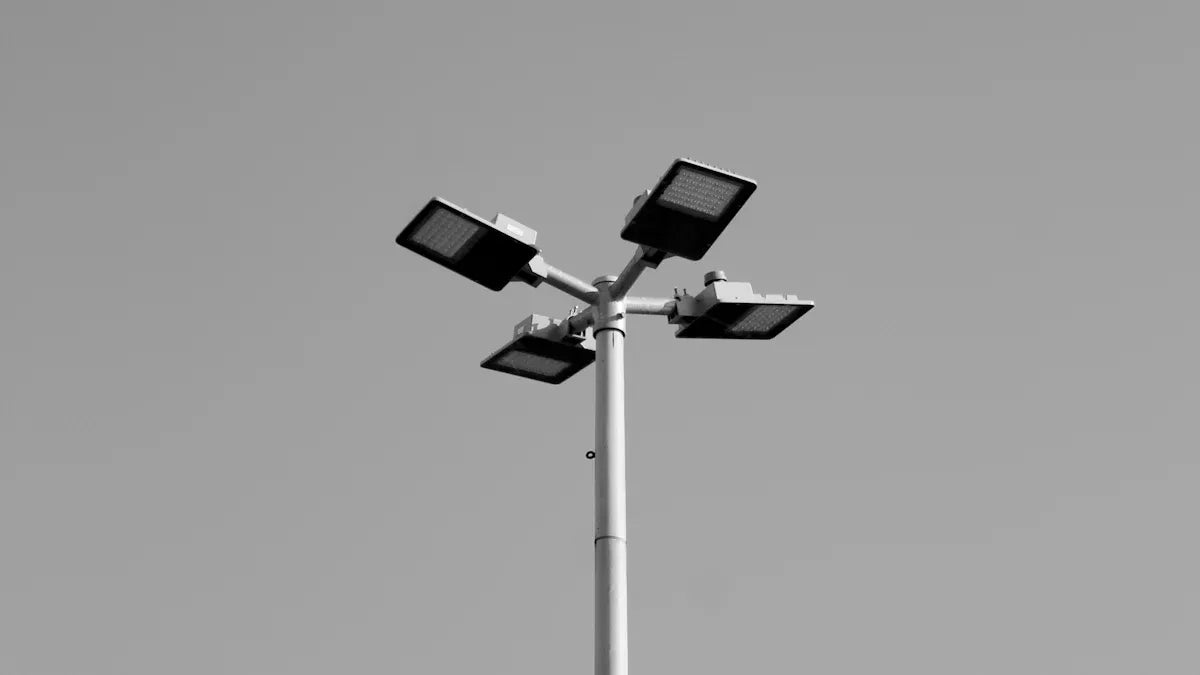Solar street lights differ most in pole height, power, and coverage. Municipal high-pole street lights use taller poles and stronger lights to cover highways, parking lots, and large public spaces. Residential low-pole street lights focus on safety, comfort, and cost savings for neighborhoods and smaller outdoor areas. The right solar light pole depends on the street, outdoor environment, and user needs. The table below shows typical application scenarios for each type of solar street lighting:
|
Application Scenario Category |
Examples of Use Cases |
|---|---|
|
Municipal High-Pole Solar Street Lights |
Highway lighting, Street/road lighting, Walkway/pathway lighting, Parking lot lighting, Residential public lighting, Park/campus/tourist resort lighting, Industrial park/construction site lighting, Sign/billboard lighting, Security/temporary lighting |
Choosing between municipal and residential solar street lights requires considering solar energy efficiency, renewable energy goals, outdoor lighting needs, and cost.
Key Takeaways
- Municipal high-pole solar street lights use tall poles and powerful LEDs to light large areas like highways and parking lots, ensuring safety and wide coverage.
- Residential low-pole solar street lights have shorter poles and softer light, making them ideal for neighborhoods, gardens, and small streets with easy installation.
- Smart controls in both types help save energy by adjusting brightness based on movement and allow remote monitoring for easier maintenance.
- Durable materials like stainless steel and aluminum protect municipal lights from harsh weather, while residential lights use weather-resistant materials to last long.
- Municipal lights have higher upfront costs but offer long-term savings through energy efficiency and reduced maintenance.
- Residential lights cost less initially, run off-grid, and require minimal upkeep, making them great for remote or smaller areas.
- Choosing the right solar street light depends on the area size, lighting needs, budget, and desired features like brightness and smart controls.
- Regular maintenance, such as cleaning solar panels and checking batteries, helps both types perform reliably and last longer.
Comparison Table
Solar Street Lights Parameters
Solar street lights serve different needs in municipal and residential environments. The following table compares the main parameters of municipal high-pole and residential low-pole solar street lights. This comparison helps explain why each type fits its intended application.
|
Feature |
Municipal High-Pole Solar Street Lights |
Residential Low-Pole Solar Street Lights |
|---|---|---|
|
Pole Height |
8–15 meters |
3–6 meters |
|
LED Power |
80W–400W |
6W–60W |
|
Brightness (Lumens) |
Up to 36,000 |
600–650 |
|
Brightness (Lux) |
30–50 Lux (vehicle lanes) |
10–20 Lux (pedestrian paths) |
|
Solar Panel |
200W–800W, dual-tilt |
12W–200W, single flat |
|
Battery Capacity |
100Ah–500Ah LiFePO₄, 5–7 days backup |
3–4 days backup |
|
Wind Resistance |
Level 12 (36.9 m/s) |
Level 10 (24.5 m/s) |
|
Smart Features |
Intelligent dimming, remote control, sensors |
Simple controls, anti-glare, USB ports |
|
Material & Durability |
Steel/aluminum alloy, corrosion resistant |
Aluminum alloy, moderate resistance |
|
Installation |
Professional, deep base |
DIY-friendly, easy setup |
|
Application |
Highways, main roads, parking lots, parks |
Pathways, gardens, patios, small streets |
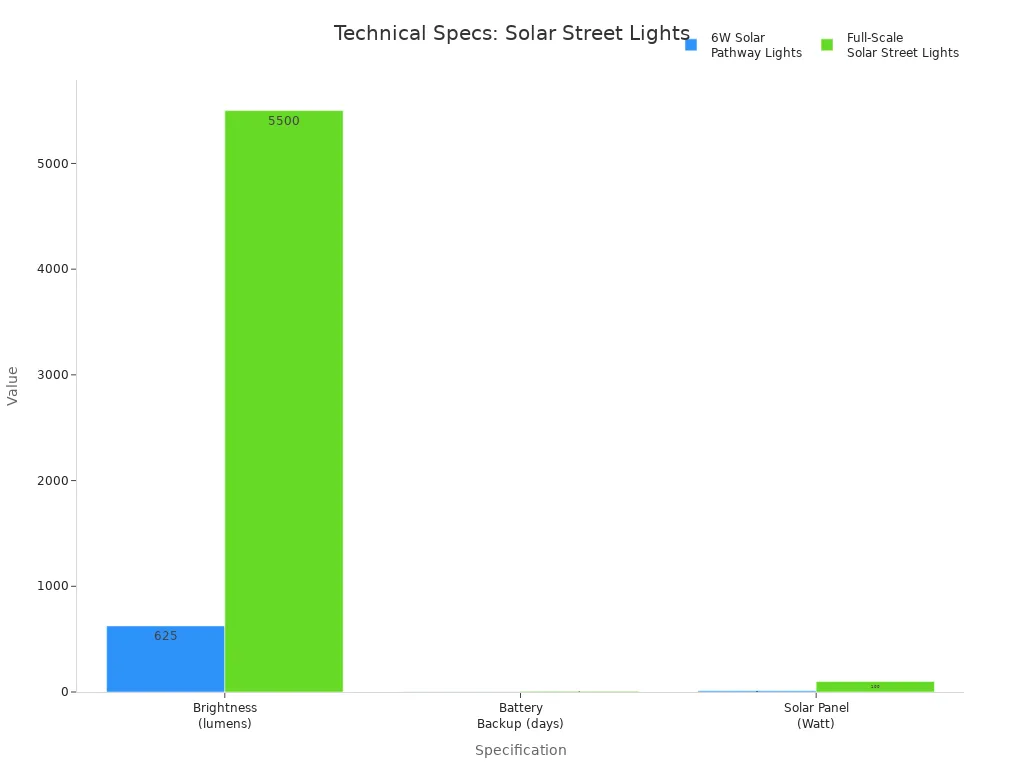
Key Differences
Municipal high-pole solar street lights stand out because they deliver high power and broad coverage. These lights use tall poles, powerful LEDs, and large solar panels to provide strong illumination for highways, city roads, and large public spaces. Their design supports extreme weather, with wind resistance up to Level 12 and advanced smart features like remote monitoring and intelligent dimming. These features explain why cities choose high-pole solar street lights for critical infrastructure.
Residential low-pole solar street lights focus on safety, comfort, and energy savings. They use shorter poles and lower power LEDs, which produce softer light suitable for pathways, gardens, and patios. Their easy installation and user-friendly features, such as anti-glare baffles and USB ports, make them ideal for neighborhoods and small outdoor areas. These lights help reduce light pollution and support energy conservation goals.
- Municipal high-pole lights use more solar energy and solar power to meet the demands of busy streets and large areas.
- Residential low-pole lights prioritize energy efficiency and simple maintenance for smaller, quieter spaces.
- The choice of solar light pole depends on the street’s size, lighting needs, and the desired balance between performance and cost.
When selecting solar street lights, users should consider the area’s size, the required brightness, and the importance of smart features. Municipal projects often require robust, high-performance solutions, while residential areas benefit from cost-effective, easy-to-maintain lights.
Municipal High-Pole Solar Street Lights
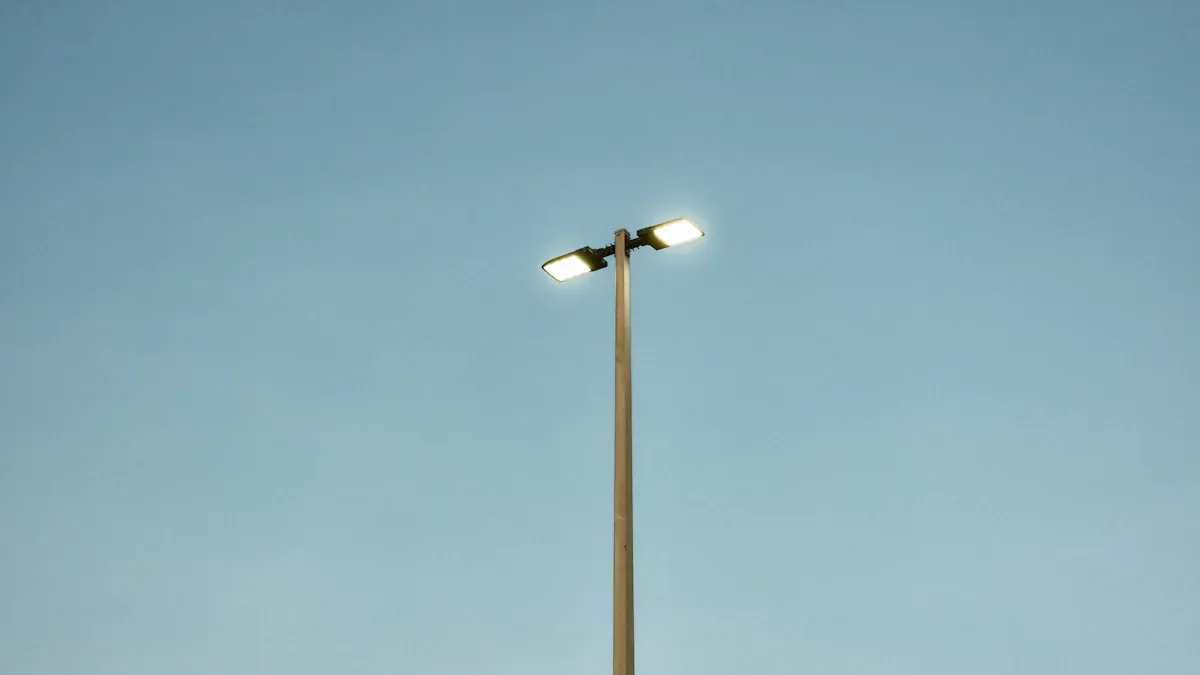
Structure and Materials
Pole Design
Municipal high-pole solar street lights use advanced engineering to meet the demands of busy roads and large public spaces. The pole stands tall, usually between 8 and 15 meters, which allows the lights to cover wide outdoor areas and improve visibility for both vehicles and pedestrians. Engineers select materials such as stainless steel, aluminum alloy, and cast iron for the pole. Each material offers unique benefits. Stainless steel resists corrosion and wind, making it ideal for humid or coastal environments. Aluminum alloy provides a lightweight yet strong structure, which simplifies installation and maintenance. Cast iron delivers extra durability, especially on rough roads or in areas with frequent vibrations.
|
Component |
Common Materials |
Impact on Durability and Suitability |
|---|---|---|
|
Street Lamp Pole |
Stainless steel, Aluminum alloy, Cast iron |
Stainless steel: corrosion and wind resistant, good for humid/coastal areas. Aluminum alloy: lightweight, strong, easy to maintain. Cast iron: sturdy, durable, good for poor road conditions. |
|
Solar Panels |
Monocrystalline silicon, Polycrystalline silicon, Amorphous silicon |
Monocrystalline: high efficiency, stable, costly. Polycrystalline: cost-effective, slightly lower efficiency. Amorphous: flexible, simple manufacturing. |
|
Batteries |
Lead-acid, Lithium, Nickel hydrogen |
Lead-acid: economical, heavy, needs maintenance. Lithium: compact, long lifespan, costly. Nickel hydrogen: eco-friendly, lower capacity. |
|
Lampshades |
PC (polycarbonate), Acrylic, Glass |
PC: impact resistant, weather durable. Acrylic: good transparency, lower impact resistance. Glass: excellent transparency, fragile. |
|
Controllers |
Aluminum alloy, Plastic, Stainless steel |
Aluminum alloy: good heat dissipation, corrosion resistant. Plastic: cheap, prone to deformation in heat. Stainless steel: corrosion resistant, good for humid environments. |
Durability
Why do cities choose these materials for solar street lights? The answer lies in the need for long-term reliability and safety. Stainless steel and aluminum alloy resist rust, which is crucial for outdoor installations exposed to rain, snow, and pollution. Polycarbonate lampshades protect the led solar lights from impacts and harsh weather, while advanced coatings shield the pole from UV rays and dust. These choices reduce maintenance costs and extend the lifespan of the street lights, making them a smart investment for municipal projects.
Performance and Features
LED Power
Municipal high-pole solar street lights rely on powerful led solar lights to deliver high brightness and clear visibility. These led fixtures often reach 80W to 400W, producing up to 36,000 lumens. This level of illumination ensures that highways, intersections, and large parking lots remain safe and well-lit, even during foggy or rainy nights. The high wattage allows the lights to penetrate poor weather conditions, which is essential for security and traffic safety.
Coverage
The tall pole and strong led solar lights work together to maximize coverage. A single solar light pole can illuminate a large area, reducing the number of fixtures needed. This design not only saves energy but also lowers installation and maintenance costs. The wide coverage supports both vehicle and pedestrian traffic, improving security lighting and reducing dark spots that could pose risks.
Smart Controls
Why do municipal solar street lights feature advanced smart controls? These systems use sensors and remote management to optimize energy use and enhance security. IoT connectivity allows real-time monitoring of each street light’s performance, battery status, and energy consumption. Motion sensors adjust brightness based on traffic flow, increasing efficiency and extending battery life. Integration with smart city infrastructure enables the lights to support public safety, environmental monitoring, and even EV charging stations. These features help cities reduce operational costs and environmental impact while maintaining reliable outdoor lighting.
Smart controls in municipal high-pole solar street lights enable adaptive lighting, remote diagnostics, and efficient energy management, supporting both sustainability and public safety goals.
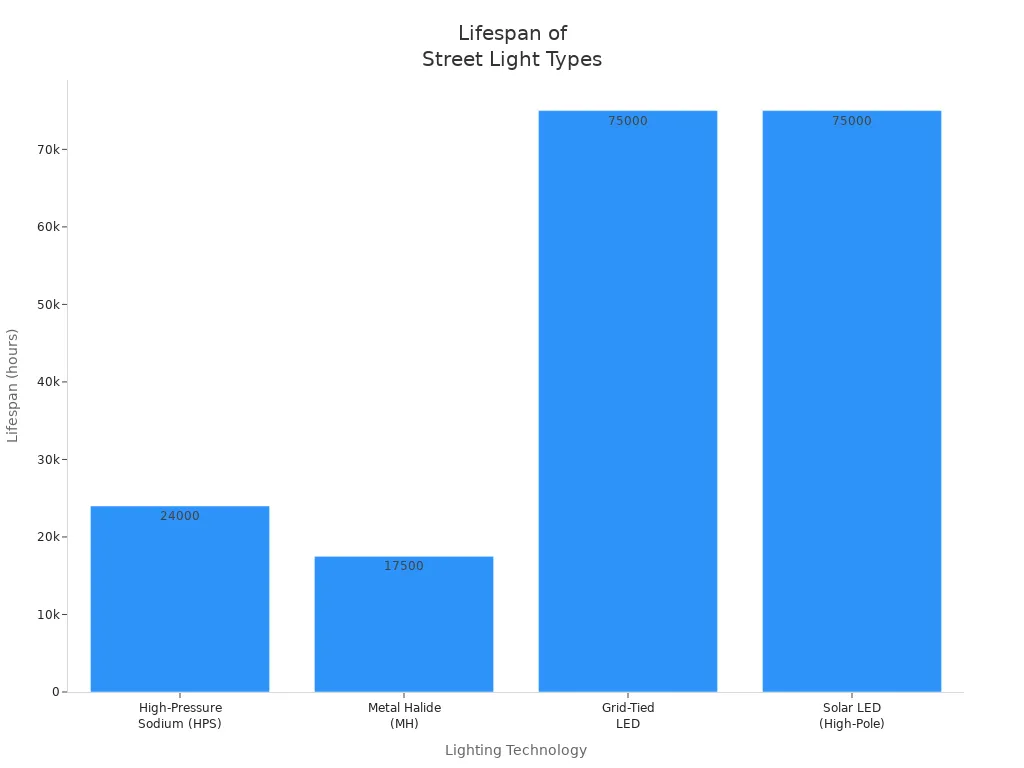
Environmental Adaptation
Municipal high-pole solar street lights must perform reliably in extreme outdoor conditions. Engineers design the pole and solar panels to withstand high winds, heavy rain, and snow. Reinforced mounting systems anchor the pole securely, while wind shields and strategic panel angles reduce the risk of damage. Weather-resistant materials like aluminum and stainless steel prevent corrosion, and protective coatings guard against UV rays and dust. Battery insulation and backup systems ensure the lights continue to operate during cold winters or cloudy days. These adaptations help cities maintain consistent street lighting, reduce environmental impact, and support public security in all weather.
Pros and Cons
Municipal high-pole solar street lights offer many benefits that explain why cities and large communities choose them for public lighting. These advantages stem from their advanced design, smart features, and robust construction. However, some challenges also exist, especially in terms of cost and environmental adaptation. Understanding both sides helps decision-makers select the right solution for their needs.
Why do municipal high-pole solar street lights stand out in urban environments?
- They enhance safety by automatically increasing brightness when pedestrians or vehicles approach. This feature ensures that roads and public spaces remain well-lit during periods of activity, reducing the risk of accidents.
- The high lumen output provides strong illumination, making it easier for drivers and pedestrians to see clearly at night or in poor weather. This level of brightness supports security and traffic flow.
- Smart controls, such as motion sensors and remote management, allow the lights to adjust their output based on real-time conditions. This automation saves energy and extends battery life.
- The pole design uses durable materials that withstand harsh weather, including heavy rain, strong winds, and extreme temperatures. This durability means the lights require less maintenance and last longer.
- Efficient solar panels maximize energy absorption, even in less-than-ideal sunlight. This efficiency ensures that the lights operate reliably throughout the night.
- Long-lasting battery storage provides backup power for several days, which is crucial during cloudy or rainy periods.
- Easy installation with minimal wiring reduces disruption during setup. Many case studies, such as highway projects in Uganda and Tunisia, show proven reliability and low maintenance needs.
Municipal high-pole solar street lights help cities achieve energy savings and reduce light pollution by dimming when no activity is detected. This approach supports environmental goals and lowers operational costs.
Why do some challenges arise with municipal high-pole solar street lights?
- The integration of advanced motion sensors and control systems increases the initial cost compared to basic solar street lights. Cities must weigh this investment against long-term savings and performance.
- In areas with many trees or tall buildings, sensor sensitivity may decrease. This limitation can affect the lights’ ability to detect movement and adjust brightness accurately.
- False triggering sometimes occurs when animals or blowing leaves activate the sensors. Frequent brightness changes may result, which can reduce energy efficiency.
Decision-makers should consider these pros and cons when choosing a solar street light solution. The benefits often outweigh the drawbacks, especially for large-scale projects where safety, reliability, and smart features matter most.
Residential Low-Pole Solar Street Lights
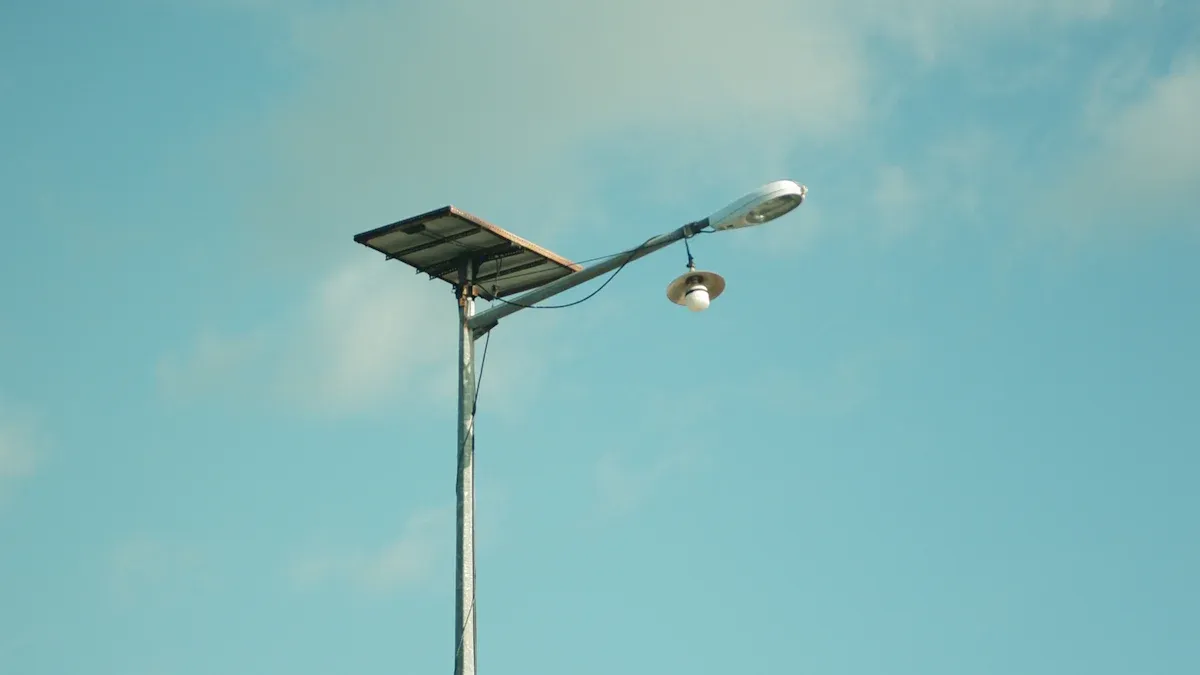
Design and Materials
Aesthetics
Why do residential low-pole solar street lights often feature unique and attractive designs? Homeowners and neighborhood planners want outdoor lighting that blends with the surrounding environment. These street lights come in a variety of styles, from classic lantern shapes to sleek, modern fixtures. Manufacturers offer different finishes and colors to match garden paths, patios, and residential streets. This variety allows communities to choose lights that enhance curb appeal and create a welcoming atmosphere.
- High-efficiency solar panels and long-lasting led solar lights are common, ensuring both beauty and sustainability.
- Durable, weather-resistant materials help these lights maintain their appearance over time.
- Aesthetic options range from traditional to contemporary, supporting different residential outdoor decors.
- Smart features, such as automatic dimming, allow the lights to adjust brightness for both comfort and energy savings.
These trends reflect a growing demand for solar street lights that improve safety and security while reducing environmental impact.
User Features
Why do residential solar street lights include user-friendly features? Residents value convenience and safety in their outdoor spaces. Many models offer anti-glare baffles to reduce eye strain and light pollution. Some designs include base-mounted USB ports, allowing people to charge devices while enjoying parks or gardens. Easy-to-use controls let users adjust lighting levels or set timers for specific needs. These features make the lights practical for daily life and support community activities after dark.
Performance and Features
LED Solar Lights
Why do manufacturers choose specific led solar lights for residential applications? The answer lies in the balance between brightness, efficiency, and longevity. Premium brands like Philips, Bridgelux, and OSRAM supply LEDs that deliver up to 240 lumens per watt, providing bright illumination with low energy use. Most residential models use LEDs rated for 30,000 to 100,000 hours, ensuring years of reliable service. The choice of LED model, such as 3030 or 5050 chips, affects both light quality and energy consumption. These led solar lights help keep outdoor areas safe and visible without excessive power draw.
|
LED Specification |
Details |
|---|---|
|
LED Brands |
Philips, Bridgelux, OSRAM, CREE |
|
LED Models |
3030, 5050 |
|
Luminous Efficiency |
Up to 240 lm/W (premium LEDs) |
|
Lifespan |
70,000 to 100,000 hours (premium LEDs) |
|
Common Chinese LEDs |
5730 chip |
|
Chinese LED Efficiency |
Around 120 lm/W |
|
Chinese LED Lifespan |
30,000 to 50,000 hours |
Coverage
Why do residential low-pole solar street lights use shorter poles? Lower poles, typically 3 to 6 meters, provide focused lighting for pathways, gardens, and small streets. This design reduces light pollution and directs illumination where it is needed most. The targeted coverage improves security lighting for pedestrians and helps prevent dark spots that could pose risks. By using fewer lights to cover a given area, communities can save on installation and maintenance costs.
Smart Controls
Why do smart controls matter for residential solar street lights? Intelligent systems allow the lights to adjust brightness based on movement or time of day. Wireless connectivity enables remote monitoring and performance tracking, making it easier for property managers to maintain the system. Features like dimming strategies extend battery life and reduce energy consumption. These smart controls support both security and sustainability goals, helping neighborhoods manage their outdoor lighting efficiently.
|
Feature / Model Type |
Residential Low-Pole Solar Street Lights |
Municipal High-Pole Solar Street Lights |
|---|---|---|
|
Smart Control Options |
Wireless connectivity, remote monitoring |
Advanced wireless, group control |
|
Battery Technology |
Power 365 smart batteries, NiMH |
Power 365, wide temp tolerance |
|
LED Efficiency and Placement |
Optimized for visibility, dark-sky compliant |
Dual luminaires, high output |
|
Maintenance |
Minimal, 10+ years performance |
Reduced, smart battery management |
|
Mounting and Pole Options |
Lower poles, flexible mounting |
Higher poles, twin luminaires |
|
Environmental Compliance |
Dark-sky friendly |
Dark-sky compliant |
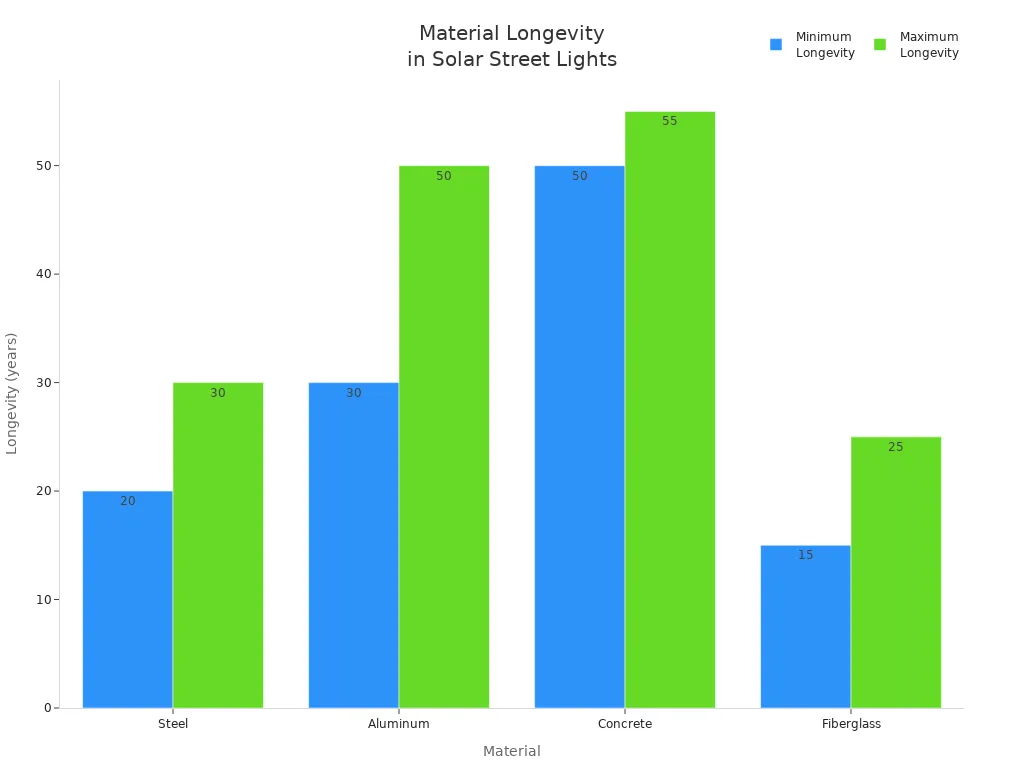
Environmental Adaptation
Why do residential low-pole solar street lights perform well in diverse climates? Manufacturers select materials like aluminum, stainless steel, and fiberglass for their resistance to corrosion, humidity, and temperature changes. Protective coatings shield metal parts from rust and UV damage. Battery enclosures often include vents or louvers to manage heat and moisture. Proper drainage and waterproofing prevent water buildup around the pole and electrical components. In cold regions, LiFePO4 batteries ensure reliable operation, while in coastal areas, corrosion-resistant housings withstand salt air. Regular cleaning and maintenance further extend the life of these street lights, ensuring consistent performance and minimal environmental impact.
Pros and Cons
Why do many communities and homeowners choose residential low-pole solar street lights? The answer lies in their unique blend of benefits that support both sustainability and convenience. These solar street lights use renewable energy, which helps reduce electricity costs and lowers carbon emissions. People often select them because they operate independently from the electrical grid, making them ideal for remote areas or places prone to power outages. The simple installation process, which does not require complex wiring, allows for flexible placement along pathways, gardens, or small streets. This ease of setup means that even areas with limited infrastructure can enjoy reliable lighting.
Many users appreciate that these lights require minimal maintenance after installation. The design of the pole and the use of durable materials help extend the lifespan of the system. Because the lights run on solar power, they contribute to lower operating costs over time. Communities that prioritize eco-friendly solutions often favor these lights for their ability to reduce reliance on fossil fuels and support environmental goals.
Main Advantages of Residential Low-Pole Solar Street Lights:
- Use of renewable solar energy, which reduces electricity bills and supports sustainability.
- Eco-friendly operation, helping to lower carbon emissions and promote green living.
- Minimal operational costs after the initial investment, as there are no ongoing electricity charges.
- Easy installation without the need for electrical wiring, making them suitable for various locations.
- Complete off-grid functionality, which is especially useful in remote or disaster-prone areas.
- Low maintenance requirements, thanks to robust pole construction and weather-resistant materials.
Why do some users express concerns about residential solar street lights? While these lights offer many advantages, certain limitations exist. The initial cost of purchasing and installing the system tends to be higher than traditional lighting options. Performance can vary depending on weather conditions. For example, cloudy or rainy days may reduce the efficiency of the solar panels, leading to shorter lighting times. The batteries, which store energy for nighttime use, require periodic maintenance and eventual replacement. Some users also note that the light output and coverage area are more limited compared to municipal systems, so larger spaces may need multiple units. In some neighborhoods, the risk of vandalism or theft of valuable components like solar panels and batteries remains a concern.
Potential Drawbacks of Residential Low-Pole Solar Street Lights:
- Higher upfront costs compared to conventional streetlights.
- Dependence on sunlight, which can affect performance during cloudy or rainy periods.
- Batteries need maintenance and replacement every few years to ensure reliable operation.
- Limited light output and coverage, sometimes requiring several poles for larger areas.
- Vulnerability to theft or vandalism, especially in less secure locations.
Communities and homeowners should weigh these pros and cons when deciding why residential low-pole solar street lights might be the right choice for their needs. The decision often depends on priorities such as sustainability, budget, and the specific lighting requirements of the area.
Choosing Solar Street Lights
Application Area
Why does the application area matter when selecting solar street lights? The answer lies in the unique requirements of each environment. Highways, city streets, and large public spaces demand powerful lighting solutions. Municipal high-pole solar street lights meet these needs by providing broad coverage, high brightness, and robust reliability. These systems withstand harsh weather and deliver consistent performance, which is essential for public safety and traffic flow.
In contrast, residential streets, parks, and pathways require a different approach. Low-pole solar street lights offer focused illumination, softer light, and designs that blend with the neighborhood. These lights minimize light pollution and enhance the visual appeal of outdoor spaces. Parks and gardens benefit from compact, aesthetically pleasing fixtures that create a welcoming atmosphere for community activities.
Environmental factors also influence the choice. Locations with frequent storms or extreme temperatures need street lighting systems with high weather resistance and durable materials. Urban planners must consider the street’s size, the presence of trees or buildings, and the desired balance between performance and aesthetics. By analyzing the application area, decision-makers ensure that the selected solar street lights deliver optimal results for each unique setting.
Lighting Needs
Why do lighting needs differ between municipal and residential areas? The answer centers on safety, visibility, and comfort. Municipal streets and highways require high brightness to improve driver visibility and reduce accidents. These areas often use cooler color temperatures and wide beam angles to maximize coverage and security. Regulations set strict standards for illumination levels, glare control, and light trespass to protect both drivers and nearby residents.
Residential streets and outdoor spaces prioritize comfort and community well-being. Lower brightness levels and warmer color temperatures create a pleasant environment while preventing light spill into homes. Soft, indirect lighting supports nighttime activities without disturbing neighbors or wildlife. In parks and pathways, even and consistent lighting enhances security and encourages outdoor recreation.
Battery capacity and autonomy also play a role. Municipal street lighting systems need large batteries to ensure continuous operation during cloudy periods. Residential systems can use smaller batteries, as their lighting demands are lower. Intelligent controls, such as motion sensors and timers, help optimize energy use and extend battery life in both settings. By understanding the specific lighting needs of each street, planners can select energy-efficient solutions that support safety, sustainability, and community goals.
Budget and Installation
Why does budget influence the choice between municipal high-pole and residential low-pole solar street lights? The initial cost of equipment and installation varies significantly between the two types. Municipal high-pole systems require taller poles, larger solar panels, and advanced smart features, resulting in higher upfront costs. These systems often range from $1,800 to $5,000 per unit, including equipment and labor. However, they offer long-term savings by eliminating electricity bills and reducing maintenance expenses.
Residential low-pole solar street lights present a more affordable option for smaller projects. The cost of a typical pole ranges from $700 to $1,200, with light units costing $90 to $400. Installation is usually quicker and less complex, as these systems do not require grid connections or extensive trenching. This makes them ideal for neighborhoods, parks, and pathways where budget constraints are a concern.
Why do smart features matter for long-term savings? Intelligent controls, such as remote monitoring and dimming, reduce operational costs by optimizing energy use and minimizing maintenance. LED technology and advanced batteries extend the lifespan of the system, further lowering replacement and repair costs. By weighing the initial investment against long-term benefits, decision-makers can choose solar street lights that support a sustainable future while meeting financial goals.
Tip: Always consider the total cost of ownership, including installation and maintenance, when planning a street lighting project. Investing in energy-efficient and durable solar street lights ensures reliable performance and supports sustainability for years to come.
Maintenance
Why does maintenance play a crucial role in the long-term success of solar street lighting projects? The answer lies in the unique design and technology behind both municipal high-pole and residential low-pole solar street lights. These systems use advanced components that reduce the need for frequent repairs and lower the total cost of ownership.
Solar street lights require less maintenance than traditional grid-tied streetlights. The absence of underground cabling and the use of long-lasting LEDs and batteries mean fewer failure points. Most maintenance tasks involve simple periodic inspections of the pole, foundation, and battery status. Smart control systems and advanced battery regulators help keep the batteries healthy for many years, which further reduces the need for hands-on servicing.
Regular maintenance ensures that solar street lights continue to deliver reliable performance, even after years of operation.
The following table highlights why solar street lights offer easier and more cost-effective maintenance compared to grid-tied systems:
|
Maintenance Aspect |
Grid-Tied Streetlights |
Solar Streetlights (Municipal High-Pole & Residential Low-Pole) |
|---|---|---|
|
Annual Maintenance Cost |
$250 to $400 per fixture |
Significantly lower; often 10+ years of maintenance-free operation |
|
Failure Points |
Multiple: underground cables, control units, photocells, drivers |
Minimal: no underground cabling, integrated smart controls |
|
Common Maintenance Tasks |
Lamp and driver replacements, pole inspections, cabling repairs, photocell fixes, electrical failures, vandalism repairs |
Periodic pole and foundation inspections, battery status checks, occasional hardware servicing, remote monitoring reduces labor |
|
Infrastructure Complexity |
High: requires trenching, utility coordination, diagnostic time |
Low: self-contained units, no trenching or grid interconnects |
|
Remote Monitoring |
Limited or none |
Available, reduces truck rolls and diagnostic costs |
|
Maintenance Challenges |
Cable failures, grid outages, photocell malfunctions, vandalism, complex diagnostics |
Localized failures only, smart battery control systems, modular parts |
Why do municipal high-pole solar street lights often require even less attention than expected? Their robust construction and smart monitoring features allow city managers to track performance remotely. This reduces the need for on-site inspections and helps identify issues before they become serious. The use of corrosion-resistant materials and weatherproof designs means these lights can withstand harsh environments with minimal upkeep.
Why do residential low-pole solar street lights appeal to homeowners and communities? Their simple installation and maintenance process makes them ideal for areas without technical staff. Most users only need to check the battery and clean the solar panel occasionally. Smart controls and modular parts make it easy to replace components if needed, without specialized tools or training.
- Municipal high-pole solar street lights benefit from remote diagnostics and durable engineering, which lowers maintenance costs over time.
- Residential low-pole solar street lights offer easy care and long-lasting performance, making them a practical choice for neighborhoods and parks.
Tip: Schedule regular inspections and keep the solar panels clean to maximize efficiency and extend the lifespan of your solar street lights.
Why does the combination of smart technology and durable materials make solar street lights a cost-effective solution? The answer lies in their ability to operate for many years with little intervention. This advantage supports both municipal and residential users who want reliable lighting without the burden of frequent repairs or high maintenance bills.
Recommendation
Summary
Why do decision-makers need to carefully choose between municipal high-pole and residential low-pole solar street lights? The answer lies in the unique requirements of each street environment. Municipal high-pole lights provide broad coverage and high brightness, making them ideal for highways, wide roads, and public spaces where safety and visibility matter most. These lights use durable materials like galvanized steel or aluminum, which withstand harsh weather and reduce long-term cost. Their advanced smart features and strong wind resistance ensure reliable operation in demanding conditions.
Residential low-pole solar street lights suit neighborhoods, pathways, and gardens. They use lower poles, usually between 10 and 15 feet, to create a comfortable atmosphere without overwhelming the environment. These lights focus on aesthetics, energy efficiency, and easy installation. Homeowners and planners often select them to reduce light pollution and support a sustainable future.
Industry experts recommend matching pole height and lamp power to the width of the street and the level of traffic. The table below summarizes these recommendations:
|
Application Area |
Recommended Pole Height |
Additional Notes |
|---|---|---|
|
Residential (narrow roads, 5-8 meters wide) |
5-7 meters (approx. 16-23 feet) |
Suitable for lower power lamps (30-60W), single side lighting |
|
Medium width streets (8-12 meters) |
8-10 meters (approx. 26-33 feet) |
Double side lighting, moderate power (60-100W) |
|
Wide roads (>12 meters) |
10-12 meters (approx. 33-39 feet) |
Double side or median lighting, higher power (100-120W) |
Why does this matter? The right choice balances functionality, aesthetics, and energy efficiency. Planners should consider traffic flow, weather, and local regulations to ensure the best outcome for each street.
Actionable Advice
Why do professionals suggest a step-by-step approach when upgrading or installing solar street lights? Careful planning ensures that each project meets community goals and delivers long-term value. The following steps help municipalities and homeowners make informed decisions:
- Review the community’s comprehensive plan to align solar upgrades with local goals.
- Update zoning and land-use ordinances to support solar installations and manage applications effectively.
- Evaluate each project individually, focusing on minimizing negative impacts on the community.
- Consult with other cities or neighborhoods to learn from their experiences and best practices.
- Apply operational standards such as dark-sky compliant lighting, secure access, and noise limits.
- Use setbacks and vegetative screening to reduce visual and environmental impacts.
- Ensure compliance with all local, state, and federal standards, including emergency responder training.
- Develop decommissioning plans and cost estimates to restore sites after the system’s life ends.
- Seek independent third-party reviews for environmental and engineering plans.
- Consider economic impacts, including financial incentives, employment, and property values.
Why do experts recommend switching from traditional lighting to LED-based solar street lights? LEDs offer dynamic control, lower heat output, and longer lifespans—often over 50,000 hours. These features reduce maintenance cost and improve energy efficiency. LEDs also contain no hazardous materials, making them easier to recycle and safer for the environment. Communities benefit from faster returns on investment and increased awareness of sustainability.
Tip: Always select durable, weather-resistant materials for poles and fixtures. Prioritize wind resistance and foundation stability, especially for taller municipal poles. Compliance with local regulations and ease of installation will help avoid future problems and reduce overall cost.
By following these steps, decision-makers can create safer, more attractive, and energy-efficient street environments. The right solar street lights support both immediate needs and long-term community goals.
Why do communities and planners need to compare municipal high-pole and residential low-pole solar street lights? Each type serves different environments and user needs. Municipal high-pole models deliver broad coverage and durability for busy roads, while residential low-pole options focus on aesthetics and easy maintenance for neighborhoods. The table below highlights why decision-makers should prioritize specific criteria:
|
Criteria Category |
Key Considerations & Examples |
|---|---|
|
Performance & Durability |
Weather resistance, battery stability, LED lifespan |
|
Environmental Conditions |
Impact of rain, snow, fog; protective coatings |
|
Installation & Maintenance |
Ease of setup, user-friendly maintenance |
|
Energy Requirements |
Battery capacity, solar panel efficiency |
|
Aesthetic & Design |
Integration with surroundings, lighting quality |
|
Cost |
Total ownership, warranty, after-sales support |
Why should readers avoid common mistakes? Proper sizing, environmental adaptation, and supplier support prevent inefficiency and extra cost.
For complex or large-scale solar projects, professionals recommend consulting these organizations:
- Solar@Scale (ICMA & APA partnership)
- Legacy Solar Cooperative
- American Planning Association (APA)
- Solar Outreach Partnership (SolarOPs)
Why does careful planning matter? Weighing technical specs, smart features, and cost ensures the right solar street lights for every environment.
FAQ
Why do cities prefer municipal high-pole solar street lights for main roads?
Cities choose municipal high-pole solar street lights because these lights provide wide coverage and high brightness. This design improves safety for drivers and pedestrians. The tall poles also help reduce the number of lights needed for large areas.
Why do residential areas often use low-pole solar street lights?
Residential areas use low-pole solar street lights to create a comfortable and safe environment. These lights produce softer illumination, which reduces light pollution. The shorter poles also blend better with neighborhood landscapes and support easy installation.
Why do solar street lights need smart controls?
Smart controls help solar street lights adjust brightness based on activity or time. This feature saves energy and extends battery life. Smart systems also allow remote monitoring, which makes maintenance easier for both municipal and residential users.
Why does wind resistance matter for solar street lights?
Wind resistance ensures that solar street lights remain stable during storms or strong winds. Municipal high-pole lights require higher wind resistance because of their height. This feature protects the investment and keeps public spaces safely lit in harsh weather.
Why do some projects choose commercial solar parking lot lights?
Some projects select commercial solar parking lot lights to illuminate large parking areas without relying on the electrical grid. These lights offer strong performance, easy installation, and energy savings. They also support sustainability goals for businesses and public facilities.
Why do batteries play a key role in solar street light performance?
Batteries store solar energy during the day and power the lights at night. High-quality batteries ensure reliable operation, even during cloudy weather. The right battery choice extends the lifespan of the solar street light system.
Why do communities value the aesthetics of residential solar street lights?
Communities value aesthetics because attractive lighting enhances the look of neighborhoods and parks. Stylish designs and finishes help solar street lights blend with outdoor spaces. This approach creates a welcoming atmosphere for residents and visitors.
